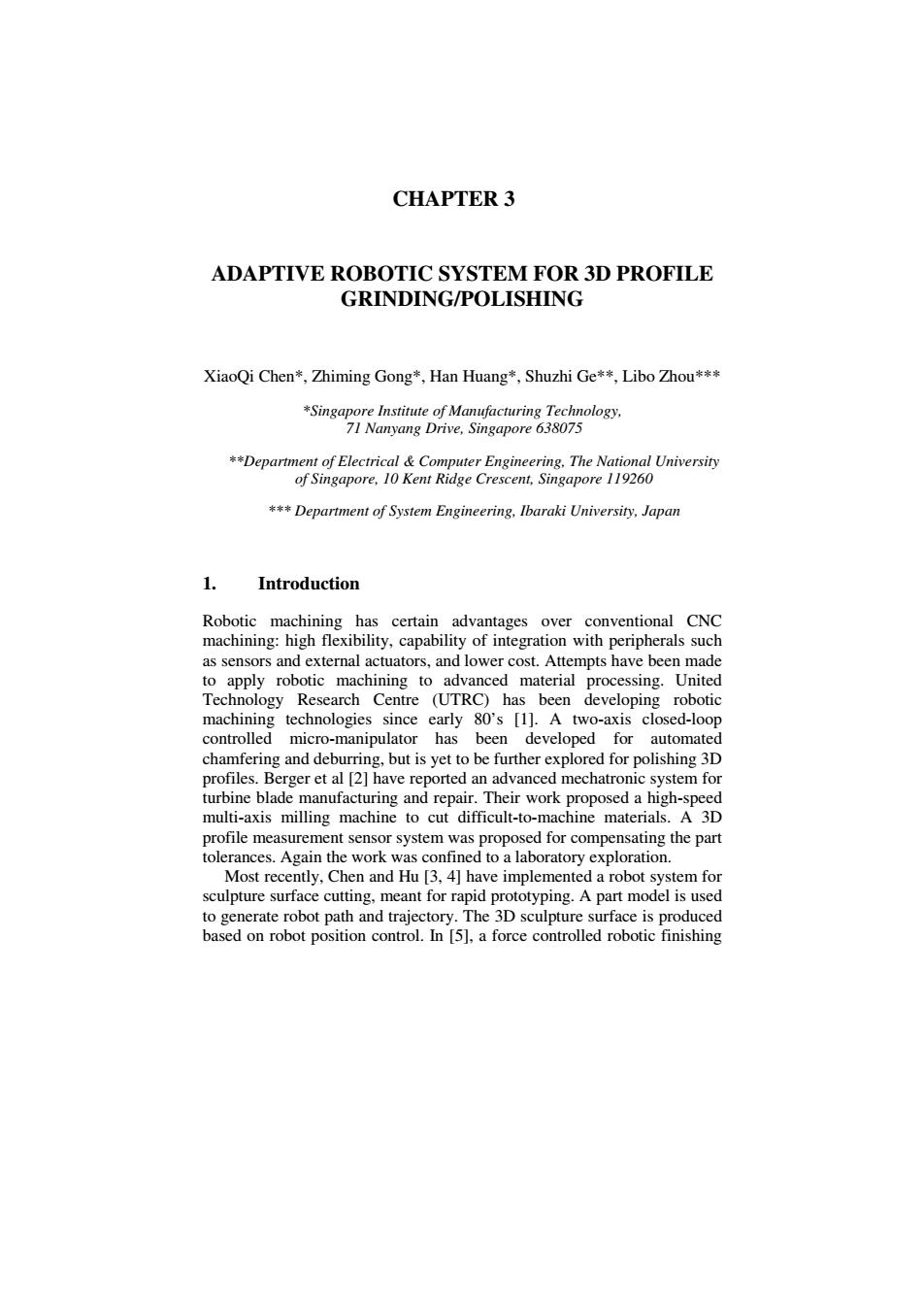正在加载图片...

CHAPTER 3 ADAPTIVE ROBOTIC SYSTEM FOR 3D PROFILE GRINDING/POLISHING XiaoQi Chen*,Zhiming Gong*,Han Huang*,Shuzhi Ge**,Libo Zhou*** *Singapore Institute of Manufacturing Technology, 71 Nanyang Drive,Singapore 638075 **Department of Electrical Computer Engineering.The National University of Singapore,10 Kent Ridge Crescent,Singapore 119260 ***Department of System Engineering,Ibaraki University,Japan 1. Introduction Robotic machining has certain advantages over conventional CNC machining:high flexibility,capability of integration with peripherals such as sensors and external actuators,and lower cost.Attempts have been made to apply robotic machining to advanced material processing.United Technology Research Centre (UTRC)has been developing robotic machining technologies since early 80's [1.A two-axis closed-loop controlled micro-manipulator has been developed for automated chamfering and deburring,but is yet to be further explored for polishing 3D profiles.Berger et al [2]have reported an advanced mechatronic system for turbine blade manufacturing and repair.Their work proposed a high-speed multi-axis milling machine to cut difficult-to-machine materials.A 3D profile measurement sensor system was proposed for compensating the part tolerances.Again the work was confined to a laboratory exploration Most recently,Chen and Hu [3,4]have implemented a robot system for sculpture surface cutting,meant for rapid prototyping.A part model is used to generate robot path and trajectory.The 3D sculpture surface is produced based on robot position control.In [5],a force controlled robotic finishingCHAPTER 3 ADAPTIVE ROBOTIC SYSTEM FOR 3D PROFILE GRINDING/POLISHING XiaoQi Chen*, Zhiming Gong*, Han Huang*, Shuzhi Ge**, Libo Zhou*** *Singapore Institute of Manufacturing Technology, 71 Nanyang Drive, Singapore 638075 **Department of Electrical & Computer Engineering, The National University of Singapore, 10 Kent Ridge Crescent, Singapore 119260 *** Department of System Engineering, Ibaraki University, Japan 1. Introduction Robotic machining has certain advantages over conventional CNC machining: high flexibility, capability of integration with peripherals such as sensors and external actuators, and lower cost. Attempts have been made to apply robotic machining to advanced material processing. United Technology Research Centre (UTRC) has been developing robotic machining technologies since early 80’s [1]. A two-axis closed-loop controlled micro-manipulator has been developed for automated chamfering and deburring, but is yet to be further explored for polishing 3D profiles. Berger et al [2] have reported an advanced mechatronic system for turbine blade manufacturing and repair. Their work proposed a high-speed multi-axis milling machine to cut difficult-to-machine materials. A 3D profile measurement sensor system was proposed for compensating the part tolerances. Again the work was confined to a laboratory exploration. Most recently, Chen and Hu [3, 4] have implemented a robot system for sculpture surface cutting, meant for rapid prototyping. A part model is used to generate robot path and trajectory. The 3D sculpture surface is produced based on robot position control. In [5], a force controlled robotic finishing